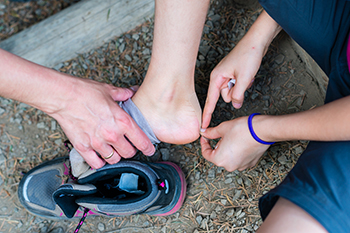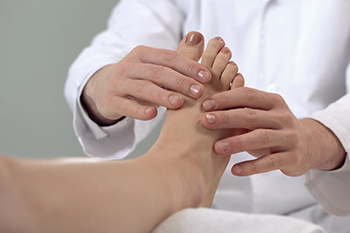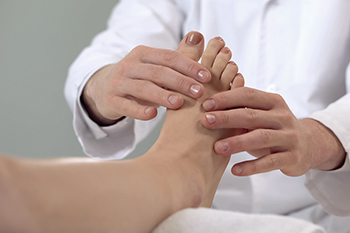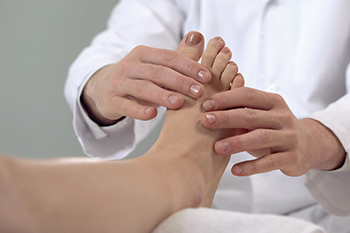Items filtered by date: September 2022
Blisters on the Bottom of the Feet

Blisters can occur on the bottom of the feet for different reasons. Causes of foot blisters include dyshidrotic eczema from seasonal allergies or stress, friction from repetitive rubbing of the feet on shoes and/or socks that are too tight, or athlete’s foot infections. However, injuries or underlying medical conditions can also lead to foot blisters. Blisters can produce issues ranging from mild discomfort to severe pain and bleeding. It is important not to try to burst a blister. If it does burst, it will likely produce more discomfort. If you have foot blisters and you do not know the cause, they are becoming worse, or not healing, seek medical advice. Diabetics should take particular heed of this advice because if they suffer from neuropathy, they may not notice that a blister may turn into an ulcer and possibly cause dangerous complications. See a podiatrist for the proper diagnosis and care of blisters.
Blisters are prone to making everyday activities extremely uncomfortable. If your feet are hurting, contact the foot specialists of Certified Foot Care. Our doctors can provide the care you need to keep you pain-free and on your feet.
Foot Blisters
Foot blisters develop as a result of constantly wearing tight or ill-fitting footwear. This happens due to the constant rubbing from the shoe, which can often lead to pain.
What Are Foot Blisters?
A foot blister is a small fluid-filled pocket that forms on the upper-most layer of the skin. Blisters are filled with clear fluid and can lead to blood drainage or pus if the area becomes infected.
How Do Blisters Form?
Blisters on the feet are often the result of constant friction of skin and material, usually by shoe rubbing. Walking in sandals, boots, or shoes that don’t fit properly for long periods of time can result in a blister. Having consistent foot moisture and humidity can easily lead to blister formation.
Prevention & Treatment
It is important to properly care for the affected area in order to prevent infection and ease the pain. Do not lance the blister and use a Band-Aid to provide pain relief. Also, be sure to keep your feet dry and wear proper fitting shoes. If you see blood or pus in a blister, seek assistance from a podiatrist.
If you have any questions, please feel free to contact our offices located in Larchmont and Brooklyn, NY . We offer the newest diagnostic and treatment technologies for all your foot care needs.
Why Do Corns Develop?

A corn is defined as a small, hardened area of skin that can form on different areas of the foot. A common place a corn can be found is on the outside of the pinky toe. Even though corns are small they can cause the gait or walking style to change. Corns may develop as a result of excess friction that is caused by wearing shoes that do not fit correctly. Some people may experience corns between the toes, and these are referred to as soft corns. When a corn forms on the bottom of the foot it is known as a seed corn. Seed corns may form from clogged sweat ducts, and it may be beneficial to wear socks that are made of breathable materials. If you have a corn on your foot, it is strongly suggested that you speak with a podiatrist who can remove it and offer you effective prevention methods.
If you have any concerns regarding your feet and ankles, contact the foot specialists of Certified Foot Care. Our doctors will treat your foot and ankle needs.
Corns: What Are They? and How Do You Get Rid of Them?
Corns can be described as areas of the skin that have thickened to the point of becoming painful or irritating. They are often layers and layers of the skin that have become dry and rough, and are normally smaller than calluses.
Ways to Prevent Corns
There are many ways to get rid of painful corns such as wearing:
- Well-fitting socks
- Comfortable shoes that are not tight around your foot
- Shoes that offer support
Treating Corns
Treatment of corns involves removing the dead skin that has built up in the specific area of the foot. Consult with Our doctors to determine the best treatment option for your case of corns.
If you have any questions please feel free to contact our offices located in Larchmont and Brooklyn, NY . We offer the newest diagnostic and treatment technologies for all your foot and ankle needs.
Wounds That Don't Heal Need to Be Checked
What Does Foot Drop Mean?

Foot drop is a symptom of another condition, generally related to some form of nerve injury. It becomes apparent when a patient is unable to lift the foot enough to clear the floor or ground while walking. The foot then drags along behind, causing a type of shuffling gait. Someone with foot drop may raise the knee higher with each step, which looks like marching. Further, the foot often slaps the ground when it is lowered, as the patient is unable to control the movement. Among the many conditions that result in foot drop are a peroneal nerve injury, an ankle injury, muscular dystrophy, a stroke, or diabetes. Even something as simple as crossing the legs while sitting can constrict the peroneal nerve and cause numbness and foot drop. A podiatrist can conduct a complete examination to determine the cause of foot drop and explore the range of treatment options available to you.
If you have any concerns about your feet, contact the foot specialists from Certified Foot Care. Our doctors can provide the care you need to keep you pain-free and on your feet.
Biomechanics in Podiatry
Podiatric biomechanics is a particular sector of specialty podiatry with licensed practitioners who are trained to diagnose and treat conditions affecting the foot, ankle and lower leg. Biomechanics deals with the forces that act against the body, causing an interference with the biological structures. It focuses on the movement of the ankle, the foot and the forces that interact with them.
A History of Biomechanics
- Biomechanics dates back to the BC era in Egypt where evidence of professional foot care has been recorded.
- In 1974, biomechanics gained a higher profile from the studies of Merton Root, who claimed that by changing or controlling the forces between the ankle and the foot, corrections or conditions could be implemented to gain strength and coordination in the area.
Modern technological improvements are based on past theories and therapeutic processes that provide a better understanding of podiatric concepts for biomechanics. Computers can provide accurate information about the forces and patterns of the feet and lower legs.
Understanding biomechanics of the feet can help improve and eliminate pain, stopping further stress to the foot.
If you have any questions please feel free to contact our offices located in Larchmont and Brooklyn, NY . We offer the newest diagnostic and treatment technologies for all your foot and ankle needs.
How Your Diet Can Contribute to Gout

Gout is a form of arthritis that occurs when crystals formed by uric acid cause painful inflammation in the joints, commonly the big toe. People typically develop gout because their body does not efficiently flush out excess uric acid through the kidneys. Certain foods contribute to the onset of gout. The top contenders are certain types of meat and seafood. In addition, alcoholic beverages like beer and sugary drinks can contribute to gout. Foods that are high in cholesterol are also believed to increase the risk of developing gout. Eating foods high in purines is not the only way to build up too much uric acid, called hyperuricemia. Poor kidney function is thought to be a factor too. If you are experiencing pain in the joint of the big toe along with redness and swelling, you may have gout. It is suggested that you contact a podiatrist who can examine the area, diagnose the cause, and offer treatment solutions.
Gout is a painful condition that can be treated. If you are seeking treatment, contact the foot specialists from Certified Foot Care. Our doctors will treat your foot and ankle needs.
What Is Gout?
Gout is a form of arthritis that is characterized by sudden, severe attacks of pain, redness, and tenderness in the joints. The condition usually affects the joint at the base of the big toe. A gout attack can occur at any random time, such as the middle of the night while you are asleep.
Symptoms
- Intense Joint Pain - Usually around the large joint of your big toe, and it most severe within the first four to twelve hours
- Lingering Discomfort - Joint discomfort may last from a few days to a few weeks
- Inflammation and Redness -Affected joints may become swollen, tender, warm and red
- Limited Range of Motion - May experience a decrease in joint mobility
Risk Factors
- Genetics - If family members have gout, you’re more likely to have it
- Medications - Diuretic medications can raise uric acid levels
- Gender/Age - Gout is more common in men until the age of 60. It is believed that estrogen protects women until that point
- Diet - Eating red meat and shellfish increases your risk
- Alcohol - Having more than two alcoholic drinks per day increases your risk
- Obesity - Obese people are at a higher risk for gout
Prior to visiting your podiatrist to receive treatment for gout, there are a few things you should do beforehand. If you have gout you should write down your symptoms--including when they started and how often you experience them, important medical information you may have, and any questions you may have. Writing down these three things will help your podiatrist in assessing your specific situation so that he or she may provide the best route of treatment for you.
If you have any questions, please feel free to contact our offices located in Larchmont and Brooklyn, NY . We offer the newest diagnostic and treatment technologies for all your foot care needs.

